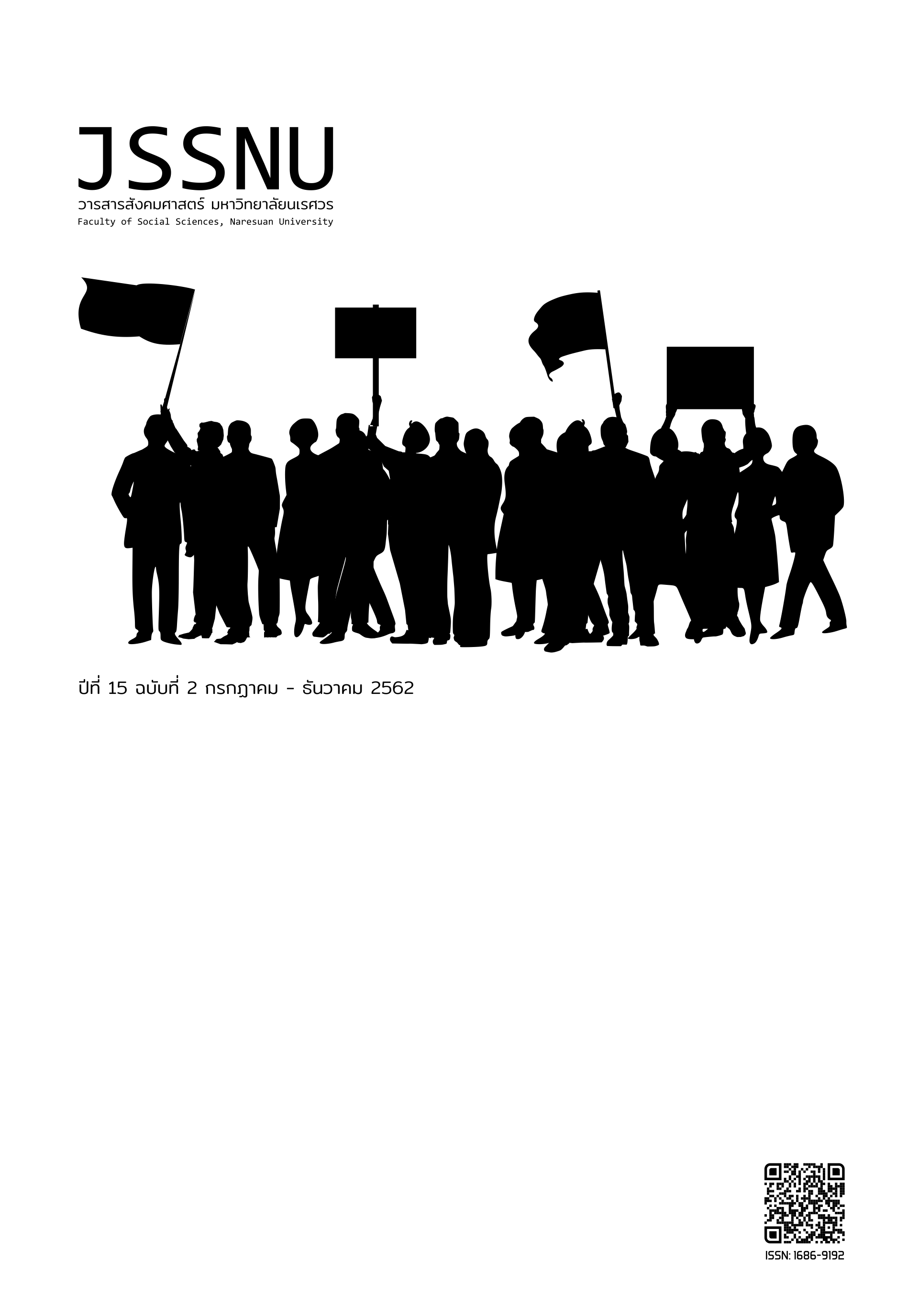Tang Chang and Art Field Before / After 14 October 1973
Main Article Content
Abstract
This article aims to survey about the role and the important works of Tang Chang after 1957, related to the change in the field of art which affected by Art for Life’s sake idea and the political event in 14 October 1973. After 1957, The Art for Life’s sake movement occurred along with the political awareness of the people. Some of the progressive artist gather into the political groups. Tang Chang is the one artist who has an independent role in The Artists’ Front of Thailand, one of the artist groups during that time, albeit he didn’t act apparent to the public. In 1973, He painted the large-scale oil painting, the self-portrait without hands and eyes. It becomes an important work in the Thai modern art history, especially in the period of political movement in the 1970s. Since Tang Chang is the artist who related to The Art for Life’s sake movement and the political movement in the 1970s, the time that Thai modern arts become independence from the state, Tang Chang has become to the artist who have worked at the fringes of (national) modernism and sit uneasily within prevailing (national) historiographies of art.
Downloads
Article Details
References
Cheng, Jia Yun. 2016. “Tang Chang,”. p.214-219. in Reframing Modernism. Singapore : National Gallery Singapore.
Poshyananda, Apinan. 1992. Modern art in Thailand : Nineteenth and Twentieth Centuries. New York: Oxford University Press.
เอกสารภาษาไทย
ก้องสกล กวินรวีกุล. 2545. การสร้างร่างกายพลเมืองไทยในสมัยจอมพล ป.พิบูลสงคราม พ.ศ. 2481-2487. (วิทยานิพนธ์ปริญญามหาบัณฑิต, มหาวิทยาลัยธรรมศาสตร์)ไชยรัตน์ เจริญสินโอฬาร. 2553. ความคิดทางการเมืองของ ฌาคส์ ร็องซีแยร์. กรุงเทพฯ: สมมติ.
เดวิด เทห์. 2559. “และแล้วความเคลื่อนไหวไม่ปรากฏ,” หน้า 131-150 (วริศา กิตติคุณเสรี, ผู้แปล). ใน เกษม เพ็ญภินันท์, กฤติยา กาวีวงศ์ และ มนูพร เหลืองอร่าม บรรณาธิการ. กว่าจะเป็นร่วมสมัย. กรุงเทพฯ: สำนักงานศิลปวัฒนธรรมร่วมสมัย.
ทีปกร. 2540. ศิลปเพื่อประชาชน. กรุงเทพฯ : หนังสือเอื้องฟ้า คณะบัญชีฯ มหาวิทยาลัยธรรมศาสตร์
นพพร ประชากุล. 2552. “ฟูโกต์กับการสืบสาวความเป็นมาของสมัยใหม่,” หน้า 165-190. ใน ยอกอักษรย้อนความคิด เล่ม 2 ว่าด้วยสังคมศาสตร์และมนุษยศาสตร์. กรุงเทพฯ: อ่าน.
นวภู แซ่ตั้ง. 2562. “ทบทวนงานศึกษาเกี่ยวกับ จ่าง แซ่ตั้ง ในบริบทศิลปะไทยสมัยใหม่,” หน้า 2164-2175 ใน รายงานสืบเนื่องจากการประชุมวิชาการระดับชาติ พะเยาวิจัย 8. พะเยา: มหาวิทยาลัยพะเยา.
แนวร่วมศิลปินแห่งประเทศไทย. 2539. พลานุภาพศิลปะกับสังคม. กรุงเทพฯ : ศิลปวรรณกรรม
ไพศาล ธีรพงศ์วิษณุพร. 2546. “14 ตุลา’ 16 ต่างสายตาความคิดของคนศิลปะ”, หน้า 30-37 ใน สำนักงานศิลปวัฒนธรรมร่วมสมัย 14 ตุลา ผ่านสายตาศิลปิน. กรุงเทพฯ: สำนักงานศิลปวัฒนธรรมร่วมสมัย.
ลักษณวัต ปาละรัตน์. 2551. สุนทรียศาสตร์. กรุงเทพฯ: มหาวิทยาลัยรามคำแหง.
วรารัตน์ คงจิตร. 2560. การเมืองการปกครองไทยกับการพัฒนารูปแบบงานจิตรกรรมร่วมสมัยในประเทศไทย (พ.ศ.2481-2519). วารสารมนุษยศาสตร์ ฉบับบัณฑิตศึกษา 6 (1): 49-69.
วีระจักร์ สุเอียนทรเมธี. 2557. พัฒนาการแนวคิดและแบบลักษณ์ศิลปะตะวันตกอย่างสังเขป. กรุงเทพฯ : มหาวิทยาลัยธรรมศาสตร์.
สันติ อิศโรวุธกุล. 2552, 1 มิถุนายน. “บทสัมภาษณ์สันติ อิศโรวุธกุล“. สืบค้นจาก https://www.14tula.com/document/interview_santi.html. [บทสัมภาษณ์].
สิทธิเดช โรหิตะสุข. 2552. กลุ่มศิลปวัฒนธรรมในประเทศไทย : บทสำรวจสถานภาพและความเคลื่อนไหวในช่วงปีพุทธศักราช 2516 – 2530. กรุงเทพฯ: มหาวิทยาลัยศรีนครินทรวิโรฒ.
สิริรัตน์ เรืองวงษ์วาร. 2539. ประวัติศาสตร์การเมืองไทยตั้งแต่เปลี่ยนแปลงการปกครอง พ.ศ.2475 จนถึงปัจจุบัน. กรุงเทพฯ: มหาวิทยาลัยรามคำแหง.
สุชิน ตันติกุล, สุขุม นวลสกุล และวิศิษฐ์ ทวีเศรษฐ. 2554. “กบฏ ปฏิวัติ รัฐประหาร,” หน้า 61-80 ใน วิศิษฐ์ ทวีเศรษฐ, สุขุม นวลสกุล และวิทยา จิตนุพงศ์. การเมืองและการปกครองไทย. กรุงเทพฯ: มหาวิทยาลัยรามคำแหง.
สุธี คุณาวิชยานนท์. 2545. จากสยามเก่า สู่ไทยใหม่ : ว่าด้วยความพลิกผันของศิลปะจากประเพณีสู่สมัยใหม่และร่วมสมัย. กรุงเทพฯ: มหาวิทยาลัยศิลปากร.
Translated Thai References
Charoensin-o-larn, Chairat. 2010. The Political Thought of Jacques Ranciere. Bangkok : Sommadhi.
Isrowuttakul, Santi. 2009, 1 June. Interview by Chotisak Onsoong.https://www.14tula.com/document/interview_santi.html. [Interview].
Kawinraweekun, Kongsakon. 2002. Constructing the Body of Thai Citizens during the Phibun Regime of 1938-1944. MA. Thesis, Thammasat University.
Kongchit, Wararat. 2017. Thai Political and the development of Contemporary Painting in Thailand (1938 – 1976). Humanities Journal, Graduate Studies 6 (1): 49-69.
Kunavichayanont, Sutee. 2002. From Old Siam to New Thai : On Traditional Art to Modern and Contemporary. Bangkok: Silpakorn University.
Palaratana, Laksanawat. 2008. Aesthetics. Bangkok: Ramkhamhaeng University.
Prachakul, Nopporn. 2009. “Foucault and the genealogy of Modernism,”. p.165-190 in Revise Art and Thinking 2 On Social Science and Humaities. Bangkok : Read
Rohitasuk, Sittidech. 2009. The Group of Art and Culture in Thailand : Survey of Status and Movement in 1973 – 1987. Bangkok: Srinakharinwirot University
Ruangwongwan, Sirirat. 1996. History of Thai Political From 1932 to the Present. Bangkok: Ramkhamhaeng University.
Sae-tang, Nawapooh. 2019. “Review of Studies About Tang Chang in Context of Modern Art in Thailand”, p.2164-2175. in Proceedings of Phayao Research Conference , Phayao: Phayao University.
Suyantaramethee, Weerachak. 2014. Survey of Western Art Development. Bangkok: Thammasat University .
Tantikul, Suchin, Nualsakul, Sukhum and Thaweeset, Wisit. 2011. “Rebel, Revolution and Coup,”. p.61-80. in Wisit Thaweeset, Sukhum Nualsakul and Wittaya Jitnupong. Thai Political and Government. Bangkok Ramkhamhaeng University
Teepakorn. 1997. Art for Life’s Sake. Bangkok : Uangfa Book, Faculty of Accountant, Thammasat University.
Teh, David. 2014. “Travelling without Moving,”. p.131-150 (Warisa Kittikunseree, Trans.) in Kasem Phenpinant, Gridtiya Gaweewong and Manuporn Luengaram (eds.). Until Contemporary. Bangkok: Office of Contemporary Art and Culture
Theerapongvisanuporn, Paisal. 2003.”14 Oct. 73 The different views of art world,” p.30-37. In Office of Contemporary Art and Culture. 14 Oct in the Artist Views. Bangkok : Office of Contemporary Art and Culture.
United Artists’ Front of Thailand. 1996. Power of Art and Social. Bangkok : Art and Literature.


